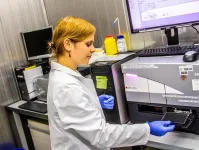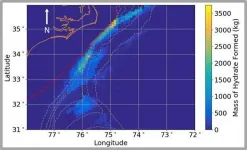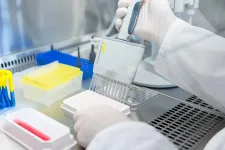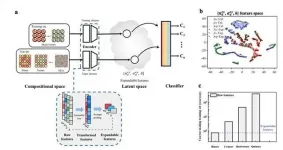(Press-News.org) A new study uncovers which cell types can be infected by SARS-CoV-2 due to their viral entry factors. The study also suggests that increased gene expression of these viral entry factors in some individuals partially explains the differences of COVID-19 severity reported in relation to age, gender and smoking status. The study evolved from the Human Cell Atlas Lung Biological Network with main contributions from Helmholtz Zentrum München, the Broad Institute of MIT and Harvard, the Wellcome Sanger Institute and University Medical Center Groningen.
COVID-19 does not affect everyone in the same way. While the coronavirus SARS-CoV-2 primarily manifests in the lung, it can infect other organs, too. Clinical observations throughout the pandemic also suggest that some population groups - such as elderly people, men and smokers - tend to be more severely affected by the disease. So far, the molecular reasons for this have not been described.
Previous studies had shown that in order to infect human cells, SARS-CoV-2 needs the cell to contain specific genetic viral entry factors - namely an ACE2 receptor and a protease (TMPRSS2 or CTSL). Knowing which cell types express both ACE2 and a protease would therefore give us information about which cells can potentially be infected with SARS-CoV-2.
The Human Cell Atlas (HCA) consortium is aiming to map every cell type in the human body, transforming our understanding of biology and disease. Within this, researchers from the HCA Lung Biological Network joined forces to contribute and analyse gene expression data from individual cells. Together, they analysed more than 100 datasets of single-cell gene expression of healthy people, to see which cell types express both ACE2 and a protease.
The analysis showed that specific cell types in the epithelium of the lung and airways, but also in the liver, the colon, and the eye are rich in genetic viral entry factors (=high expression of ACE2 receptor and a protease) - and therefore contain the necessary molecules to allow SARS-CoV-2 infection.
Moreover, the researchers found that the expression of genes underlying the viral entry factors is increased in the cells of elderly people and slightly in men compared to women. In addition, cells from smokers (in particular airway cells) express more SARS-CoV-2 entry factors than from non-smokers. These findings match differences in disease severity that have been reported for COVID-19 patients in those population groups and thus offer a molecular explanation for this difference (next to other factors which were not investigated in this study such as a weaker immune system).
Big data for biomedical research
"Fighting the pandemic, we cannot rely on conclusions that are limited to a few observations only. Instead, we must rely on robust analysis of big data. For example, to assess whether the ACE2 receptor required for virus entry is more abundant in cells of the elderly population, we need a strong representation of many diverse individuals in our dataset. Using data from the Human Cell Atlas, we could model how genetic viral entry factors in cells are expressed across the population," says Malte Lücken, computational biologist at Helmholtz Zentrum München and co-first author of the study.
"A key aspect of this large-scale study was the age range of samples we were able to analyse. This study included data from human developmental stages, samples from children and young adults, as well as samples from elderly people. This gave us unique power to assess changes occurring over the human lifetime. The sheer scale of the data allowed us to see molecular differences with age, sex and smoking status," said Kerstin Meyer, an author on the paper from the Wellcome Sanger Institute.
"This study was the epitome of a whole field coming together. Within the Human Cell Atlas consortium everyone who generated data on the healthy human lung contributed their data, both published and unpublished, to enable our analysis. When we then reached out beyond the consortium, more labs also contributed data to the effort. Only through these contributions was our analysis made possible," adds Fabian Theis, Director of the Institute of Computational Biology at Helmholtz Zentrum München.
Strengths and limitations
The study investigated which cells are most likely to be infected by SARS-CoV-2. The results partially explain how disease severity might differ between population groups because of the molecular profile of cells. This provides a target for further intervention research. Moving forward, the findings may also help to better understand the spread of the corona virus across the body. The connection between viral entry factor expression and increased ease of infection or disease severity has been shown in mice and in the lab, but requires further validation in humans.
INFORMATION:
Helmholtz Zentrum München
Helmholtz Zentrum München is a research center with the mission to discover personalized medical solutions for the prevention and therapy of environmentally-induced diseases and promote a healthier society in a rapidly changing world. It investigates important common diseases which develop from the interaction of lifestyle, environmental factors and personal genetic background, focusing particularly on diabetes mellitus, allergies and chronic lung diseases. Helmholtz Zentrum München is headquartered in Neuherberg in the north of Munich and has about 2,500 staff members. It is a member of the Helmholtz Association, the largest scientific organization in Germany with more than 40,000 employees at 19 research centers.
The health of women aged 65 and over appears to be related, in addition to their own socioeconomic characteristics, with that of their partners, as a result of traditional gender norms. This is one of the main conclusions of research led by Jordi Gumà, a researcher at the UPF Department of Political and Social Sciences, conducted in conjunction with Jeroen Spijker, a Ramon y Cajal I3 researcher at the Centre for Demographic Studies of the Autonomous University of Barcelona (CED-UAB), focusing on the case of Spain.
The study, published in Gaceta Sanitaria, analyses the health differences among the Spanish ...
An international team of scientists from the University of Turku, Finland and PennState University, USA have solved a long-standing mystery of how living organisms distinguish RNA and DNA building blocks during gene expression paving the way for the design of new antiviral drugs. The new insights were published in the journal Nature Communications.
All cellular organisms use two types of nucleic acids, RNA and DNA to store, propagate and utilize their genetic information. The synthesis of DNA is carried out by enzymes called DNA polymerases and is needed to accurately transfer the genetic information from generation to generation. ...
Our immune system is very successful when it comes to warding off viruses and bacteria. It also recognizes cancer cells as potential enemies and fights them. However, cancer cells have developed strategies to evade surveillance by the immune system and to prevent immune response.
In recent years, fighting cancer with the help of the immune system has entered into clinical practice and gained increasing importance as a therapeutical approach. Current therapies apply so-called immune checkpoint inhibitors. Immune checkpoints are located on the surface ...
A single-celled alga undergoes genome surgery to remove non-essential parts. This can lead to a most efficient cellular factory for producing sustainable biofuels from sunlight and carbon dioxide.
Researchers from the Qingdao Institute of BioEnergy and Bioprocess Technology (QIBEBT) of the Chinese Academy of Sciences (CAS) have stripped hundred-kilobase genome from a type of oil-producing microalgae, knocking out genes non-essential for it to function. By doing so, they have created a "genome scalpel" that can trim microalgal genomes rapidly and creatively.
The 'minimal genome' microalgae produced is potentially useful as a model organism for further study of the molecular and biological function of every gene, or as a 'chassis' strain for synthetic biologists to augment for customized ...
RALEIGH, N.C. -- Methane hydrate, an ice-like material made of compressed natural gas, burns when lit and can be found in some regions of the seafloor and in Arctic permafrost.
Thought to be the world's largest source of natural gas, methane hydrate is a potential fuel source, and if it "melts" and methane gas is released into the atmosphere, it is a potent greenhouse gas. For these reasons, knowing where methane hydrate might be located, and how much is likely there, is important.
A team of researchers from Sandia National Laboratories and the U.S. Naval Research Laboratory have developed a new system to model the likelihood of finding methane ...
Cutting-edge 3D scanners have been put to the test by researchers from the University of Southampton and partners Exceed Worldwide to help increase the quality and quantity of prosthetics services around the world.
The study, carried out within the END ...
A team of scientists led by Dietmar Krautwurst from the Leibniz Institute for Food Systems Biology at the Technical University of Munich has now identified address codes in odorant receptor proteins for the first time. Similar to zip codes, the codes ensure that the sensor proteins are targeted from inside the cell to the cell surface, where they begin their work as odorant detectors. The new findings could contribute to the development of novel test systems with which the odorant profiles of foods can be analyzed in a high-throughput process and thus could be better controlled.
The ...
Alchemy, which attempted to turn cheap metals such as lead and copper into gold, has not yet succeeded. However, with the development of alloys in which two or three auxiliary elements are mixed with the best elements of the times, modern alchemy can produce high-tech metal materials with high strength, such as high entropy alloys. Now, together with artificial intelligence, the era of predicting the crystal structure of high-tech materials has arrived without requiring repetitive experiments.
A joint research team of Professor Ji Hoon Shim and Dr. Taewon Jin (first author, currently at KAIST) of POSTECH's Department of Chemistry, and Professor Jaesik Park of POSTECH Graduate School of Artificial Intelligence have together developed a system that predicts ...
TROY, N.Y. -- Numeric anchoring is a long-established technique of marketing communication. Once a price is mentioned, that number serves as the basis for -- or "anchors" -- all future discussions and decisions. But new research shows that this phenomenon is not limited to decisions that involve numbers, the use and understanding of which require high-level cognitive thinking. Anchoring also biases judgments at relatively low levels of cognition when no numbers are involved.
In research recently published in the Journal of Behavioral Decision Making, Gaurav Jain, an assistant professor in the Lally School of Management at Rensselaer Polytechnic Institute, demonstrated that anchoring even occurs in perceptual domains, ...
Chemists all over the world are constantly searching for simple ways to make elemental nitrogen or N2 in the air available for chemical reactions. This is no easy task, as nitrogen is a particularly non-reactive gas with a triple bond, which is one of the strongest known chemical bonds. A research team at Friedrich-Alexander-Universität Erlangen-Nürnberg (FAU) has now demonstrated that calcium, a metal commonly found in nature, is able to break the highly-stable nitrogen bond and can do so at minus 60°C. This is significant for two reasons. On the one hand, the researchers at FAU have made a new discovery in terms of the bond-breaking capabilities of calcium, which had been largely disregarded in the past. On ...





